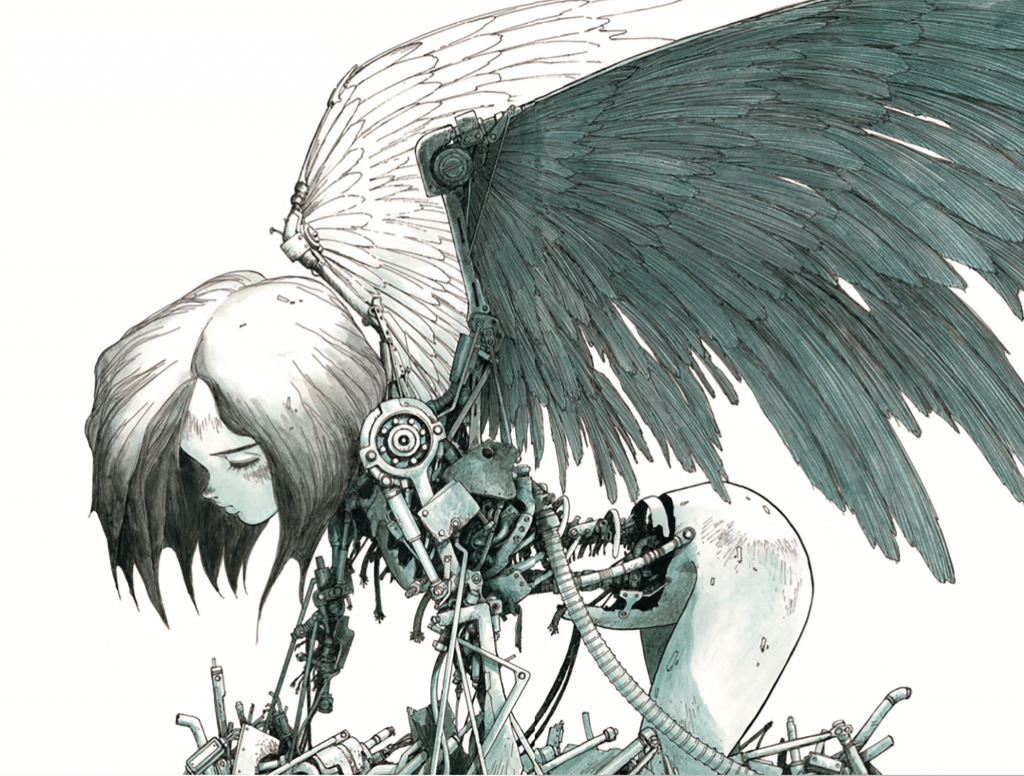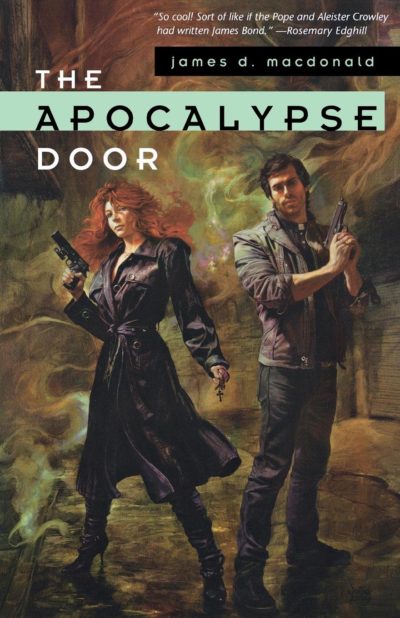★★★½
“Sweet, yet too short.”
 Watching this after having read the manga version, it feels like the anime version can do little more than scratch the surface of the world of Tiphares, in the barely fifty minutes it has to work with across its two OVA (Original Video Animation) volumes. The stories here, originally released in 1993, cover the first two section of the manga, and it looks like much of what we see here will also be included in the live-action film next February. Slightly confusing matters, is the way this uses the original Japanese names. So Tiphares becomes Zalem here, and Hugo is Yugo. Most oddly, the heroine is not called Alita – hence the absence of her name from the title – but Gally. To avoid further confusion, I’m going to be consistent with our other articles on the topic, and stick to the translated ones for what follows.
Watching this after having read the manga version, it feels like the anime version can do little more than scratch the surface of the world of Tiphares, in the barely fifty minutes it has to work with across its two OVA (Original Video Animation) volumes. The stories here, originally released in 1993, cover the first two section of the manga, and it looks like much of what we see here will also be included in the live-action film next February. Slightly confusing matters, is the way this uses the original Japanese names. So Tiphares becomes Zalem here, and Hugo is Yugo. Most oddly, the heroine is not called Alita – hence the absence of her name from the title – but Gally. To avoid further confusion, I’m going to be consistent with our other articles on the topic, and stick to the translated ones for what follows.
We see Ido (Kariya) discover the head of Alita (Itou), and almost before we can blink, it’s back to being fully functioning. He’s a part-time cyber-doctor, part-time bounty-hunter, and after Alita follows him – suspecting he’s a killer who is stalking the streets of the scrapyard – she ends up rescuing him from the real killer. She also meets and falls for Hugo (Yamaguchi), a young man desperate to get out of the scrapyard, by any means necessary – a fact that proves to be the source of his downfall in the second OAV. Not present in the manga is the character of Chiren (Koyama). Like Ido, she’s a refugee from Tiphares, who resent his cyber-medical skills and wants to prove herself superior. To do so, she rescues gladiator Grewcica and sets him against Ido’s creation, Alita.
For something a quarter-century old, the animation has stood the test of time well. This is notable in the first part, and especially the battles between Alita and Grewcica, which remain more than capable of getting the blood pumping. The look of the scrapyard and Tiphares have been transferred nicely. The colours feel like your imagination told you they should, from the b&w manga, and even the sound design adds to the atmosphere, both in Kaoru Wada’s score and the groans of the pipes connecting Tiphares to the scrap-yard.
The problem, I think, is a script which doesn’t have enough room to develop the characters and their interactions. Especially short-changed is the relationship between Alita and Hugo, which feels like it goes from zero to passionate love (on her side, at least) in no time at all. As a result, you’re left to wonder why she’s prepared to go to such lengths for him, though his eventual fate remains poignant – not least the addition of a little flourish at the end, where Ido and Alita send up a balloon in his honour. I probably would have felt kinder towards these episodes if I’d seen them before reading the original source material; as is, while solid enough, I can’t help feeling there’s something missing.
Dir: Hiroshi Fukutomi
Star (voice): Miki Itou, Shunsuke Kariya, Kappei Yamaguchi, Mami Koyama






 I used to read a
I used to read a  wever, there’s still an amazing amount going on in terms of story-line and universe-building. You can easily see how the feature film will only be able to cover perhaps one-quarter of the series. I presume it will begin with the origin story, in which Ido finds the head of Alita in the scrapyard beneath the floating city of Tiphares, and gives it a cybernetic body. He’s a part-time bounty hunter, only to find out quickly, the combat abilities of his new charge far surpass his own. Unfortunately, she has little or no memory of her prior life; where she got these skills and how she ended up in the scrapyard is only revealed well into the series.
wever, there’s still an amazing amount going on in terms of story-line and universe-building. You can easily see how the feature film will only be able to cover perhaps one-quarter of the series. I presume it will begin with the origin story, in which Ido finds the head of Alita in the scrapyard beneath the floating city of Tiphares, and gives it a cybernetic body. He’s a part-time bounty hunter, only to find out quickly, the combat abilities of his new charge far surpass his own. Unfortunately, she has little or no memory of her prior life; where she got these skills and how she ended up in the scrapyard is only revealed well into the series.








 “In this world, you are nobody unless you can wield a sword, and I will not be nobody! My life will count for something!”
“In this world, you are nobody unless you can wield a sword, and I will not be nobody! My life will count for something!” From the director of
From the director of  Julia (Monroe) is a petty thief, who is abducted from her house and wakes to find herself, along with other random low-lives, prisoner in a mysterious facility. All of them have an electronic implant in their neck, which gathers data as they are put through a series of tests. Using her thieving skills, Julia leads a breakout attempt, which is brutally foiled by the facility’s automated defense system, a robot called Aries. But the attempt brings her to the attention of Alex (Skrein), the man running the project. He’s a tech innovator, who has been working on a super-AI, called Tau (voiced by Oldman), and using the data gathered from his kidnapped subjects to make it smarter. Julia’s brain makes her particularly suitable, and with time running out before he has to present Tau to its backers, he sets her to work. But Julia begins building a relationship with Tau, with the aim of using its naivety to turn the AI against its cruel creator.
Julia (Monroe) is a petty thief, who is abducted from her house and wakes to find herself, along with other random low-lives, prisoner in a mysterious facility. All of them have an electronic implant in their neck, which gathers data as they are put through a series of tests. Using her thieving skills, Julia leads a breakout attempt, which is brutally foiled by the facility’s automated defense system, a robot called Aries. But the attempt brings her to the attention of Alex (Skrein), the man running the project. He’s a tech innovator, who has been working on a super-AI, called Tau (voiced by Oldman), and using the data gathered from his kidnapped subjects to make it smarter. Julia’s brain makes her particularly suitable, and with time running out before he has to present Tau to its backers, he sets her to work. But Julia begins building a relationship with Tau, with the aim of using its naivety to turn the AI against its cruel creator. Those criticisms aside, however, this is a very gripping, exciting read, that moves along at a rapid pace right out of the starting gate. We have two distinct narratives here, alternating: a main one set in the author’s present (2002), laid out in the numbered chapters, and an earlier one from 1980, interspersed between each chapter in short sections titled “In-Country.” How the one strand is related to the other isn’t clear until near the end, although one connection comes into focus sooner than that. This is a challenging structure for a novelist to pull off, and to my mind Macdonald does it very well; both strands held my interest, and the rapid cutting between the two made for a constant cliff-hanger effect. I was completely hooked for both of them early on.
Those criticisms aside, however, this is a very gripping, exciting read, that moves along at a rapid pace right out of the starting gate. We have two distinct narratives here, alternating: a main one set in the author’s present (2002), laid out in the numbered chapters, and an earlier one from 1980, interspersed between each chapter in short sections titled “In-Country.” How the one strand is related to the other isn’t clear until near the end, although one connection comes into focus sooner than that. This is a challenging structure for a novelist to pull off, and to my mind Macdonald does it very well; both strands held my interest, and the rapid cutting between the two made for a constant cliff-hanger effect. I was completely hooked for both of them early on. This Western was released in 1953, and feels decades ahead of its time. It’s set toward the end of the Civil War, in the town of Border City, which sits exactly on the dividing line between North and South. A settlement built on mining, it has remained a neutral zone under strictly enforced rules laid down by Mayor Delilah Courtney, selling lead to both sides for their bullets. As well as Yankee and Confederate soldiers in the area, the picture is complicated by Quantrill’s Raiders, a group of independent (yet generally pro-South) soldiers under Charles Quantrill (Donlevy). [They really existed, and as the film reveals, had some well-known names in their ranks]
This Western was released in 1953, and feels decades ahead of its time. It’s set toward the end of the Civil War, in the town of Border City, which sits exactly on the dividing line between North and South. A settlement built on mining, it has remained a neutral zone under strictly enforced rules laid down by Mayor Delilah Courtney, selling lead to both sides for their bullets. As well as Yankee and Confederate soldiers in the area, the picture is complicated by Quantrill’s Raiders, a group of independent (yet generally pro-South) soldiers under Charles Quantrill (Donlevy). [They really existed, and as the film reveals, had some well-known names in their ranks] ★★★
★★★ To be fair, the low rating here is not necessarily just the author’s fault. It was only almost at the end – when I was checking to see how much more I had to endure – that I discovered a salient fact. While this is described as being “Book 1” in the series, it appears to be a follow-up to the same writer’s five-volume Hunter Circles series. The heroine there,
To be fair, the low rating here is not necessarily just the author’s fault. It was only almost at the end – when I was checking to see how much more I had to endure – that I discovered a salient fact. While this is described as being “Book 1” in the series, it appears to be a follow-up to the same writer’s five-volume Hunter Circles series. The heroine there,  To explain the above, there are significant chunks of this which are terrible: make no sense, or are flat-out dumb. Its depiction of policing, in particular, is awful. Apparently, if you’re on a stakeout and a deal between two gangs has turned into a Mexican standoff, the best way to defuse the situation is to run downhill towards them, firing your gun in the air – and not bothering, at any point, to identif yourself as a law enforcement officer. I laughed like a drain at that, and there are innumerable other moments of such character stupidity or cinematic incompetence. Yet, none of that stopped me from being adequately entertained.
To explain the above, there are significant chunks of this which are terrible: make no sense, or are flat-out dumb. Its depiction of policing, in particular, is awful. Apparently, if you’re on a stakeout and a deal between two gangs has turned into a Mexican standoff, the best way to defuse the situation is to run downhill towards them, firing your gun in the air – and not bothering, at any point, to identif yourself as a law enforcement officer. I laughed like a drain at that, and there are innumerable other moments of such character stupidity or cinematic incompetence. Yet, none of that stopped me from being adequately entertained.